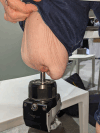Thighplasty for Transfemoral Amputations and Osseointegration: Lower Rate of Complications Than Thighplasty for Body Contouring
- PMID: 39712385
- PMCID: PMC11661763
- DOI: 10.1097/GOX.0000000000006389
Thighplasty for Transfemoral Amputations and Osseointegration: Lower Rate of Complications Than Thighplasty for Body Contouring
Abstract
Background: Modern techniques in lower extremity amputation have made significant advances to improve prosthetic control and soft-tissue envelopes through various techniques, including medial thighplasties. These advances are necessary to enhance the fit and functionality of the prosthesis in transfemoral amputations.
Methods: We performed a retrospective review of all thighplasties performed at our institution in patients with ipsilateral transfemoral amputation from November 2017 to December 2021. We recorded complication rates, types of complications, and treatments throughout this period, and compared it to thighplasty for cosmetic surgery patient outcomes. Univariate statistics were performed using the Student t test and χ2 analysis to identify differences between the complication and no-complication cohorts, as well as for comparison with published, historical, bariatric surgery, and cosmetic thighplasty controls.
Results: There were 46 combined thighplasty and osseointegration procedures, and 12 thighplasty procedures alone, and all patients had a minimum 2-year follow-up. The mean follow-up was 3.39 (2.10-4.05) years. In total, 13 (22%) patients developed a complication: 8 (57%) were due to dehiscence, 2 (14%) were due to seroma, 2 (14%) were due to superficial infection, and 1 (7%) was due to deep infection. Overall, our rate of complication was significantly lower than the overall historical complication rate (22% versus 68%, P < 0.0001).
Conclusions: We demonstrate herein that the overall complication rate for thighplasty undertaken to improve thigh contour and bulk in transfemoral amputees is lower than when thighplasty is undertaken for other indications.
Copyright © 2024 The Authors. Published by Wolters Kluwer Health, Inc. on behalf of The American Society of Plastic Surgeons.
Conflict of interest statement
The authors have no financial interest to declare in relation to the content of this article. The contents of this publication are the sole responsibility of the author(s) and do not necessarily reflect the views, opinions or policies of Uniformed Services University of the Health Sciences (USUHS), The Henry M. Jackson Foundation for the Advancement of Military Medicine, Inc., the Department of Defense (DoD), or the Departments of the Army, Navy, or Air Force. Mention of trade names, commercial products, or organizations does not imply endorsement by the US Government.
Figures


References
-
- Hebert JS, Rehani M, Stiegelmar R. Osseointegration for lower-limb amputation: a systematic review of clinical outcomes. JBJS Rev. 2017;5:e10. - PubMed
-
- Gusenoff JA, Coon D, Nayar H, et al. . Medial thigh lift in the massive weight loss population: outcomes and complications. Plast Reconstr Surg. 2015;135:98–106. - PubMed
-
- Bertheuil N, Carloni R, De Runz A, et al. . Medial thighplasty: current concepts and practices. Ann Chir Plast Esthet. 2016;61:e1–e7. - PubMed
-
- Souza JM, Mioton LM, Harrington CJ, et al. . Osseointegration of extremity prostheses: a primer for the plastic surgeon. Plast Reconstr Surg. 2020;146:1394–1403. - PubMed
-
- Al Muderis M, Lu W, Li JJ. Osseointegrated prosthetic Limb for the treatment of lower limb amputations: experience and outcomes. Unfallchirurg. 2017;120:306–311. - PubMed
Grants and funding
LinkOut - more resources
Full Text Sources
